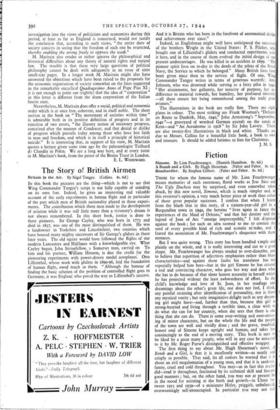The Story of British Airmen
Britain In the Air. By Nigel Tangye. (Collins. 4s. 6d-.)
IN this book the pictures are the thing—which is not to say that Wing Commander Tangye's script is not fully capable of standing on its own feet. Indeed, he gives an interesting and valuable account of the early experiments in human flight and in particular of the part which men of British nationality played in those experi- ments. The contribution which these men made to the development of aviation while it was still little more than a visionary's dream is not always remembered. In this short book, justice is done to these pioneers. Sir George Cayley, who was born in 1773 and died in 1857, was one of the most distinguished of therm He was a landowner in Yorkshire and Lincolnshire, two counties which have housed many mighty successors of Sir George's gliders in these later years. The old squire would have followed the flights of our modern Lancasters and Halifaxes with a knowledgeable eye. What Cayley began, John Stringfellow, a Somerset man, carried on To him and his partner, William Henson, is due the credit for the pioneering experiments with power-driven model aeroplanes. Otto Lillienthal, whose work with gliders in 1890-96, laid the foundation of human flight, owed much to them. "Although the honour of finding the basic solution of the problem of controlled flight goes to Germany, it was England who paved the way to Liffienthal's success.
And it is Britain who has been in the forefront of aeronautical design and achievement ever since."
• Indeed, an Englishman might well have anticipated the successes of the brothers Wright in the United States: P. S. Pilcher, who bought one of Liffienthal's gliders and conducted experiments with it here, and in the course of them evolved the initial design of our present undercarriages. He was killed in an accident in 1899. "His pioneer spirit lives on to-day in the deeds of the pilots of the Royal Navy, the Service to which he belonged." Many British lives have been given since then to the service of flight. Of one, Wing Commander Tangye writes in terms of generous warmth: Amy Johnson, who was drowned while serving as a ferry pilot in 1940. "Her attainments, her gallantry, her tenacity of purpose, her in- difference to material rewards, her humility, her profound sincerity —all these ensure her being remembered among the truly great aviators."
The illustrations in the book are really fine. There are eight plates in colour. The most striking are Frank Wootton's "Defiants en Route to Dunkirk, May, 1940," John Armstrong's "September, 1940 "—a graveyard of wrecked German aircraft on the sands of Kent—and "An Aerodrome in 1918" by Sir John Lavery. There are also twenty-five illustrations in black and white. Thanks are due to Messrs. Collins for a beautiful little book, a book to own and treasure. It should be added betimes to lists for Christmas.
J. M. S.


























 Previous page
Previous page